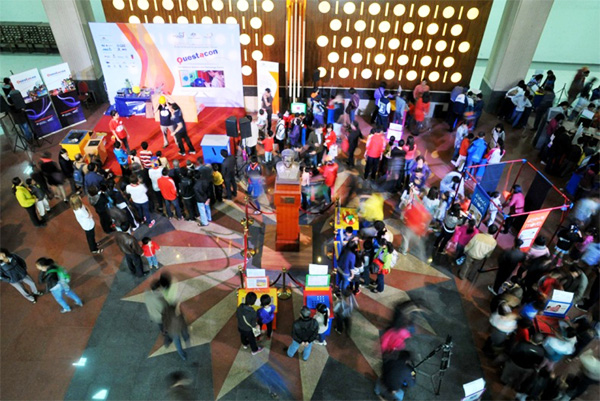12 September 2013
In April 2013 the Questacon Science Circus, with 50 travelling exhibits and three science presenters, visited Hanoi, Da Nang and Ho Chi Minh City. The Questacon tour of Vietnam, commemorating the 40th anniversary of diplomatic relations, drew 7,000 visitors, attracted extensive media coverage and showcased Australia as a leader in innovative science communication and outreach. The tour also supported Vietnam's programs to teach science in English, adopt enquiry-based learning and foster innovation in the classroom and beyond.
In each city Questacon trained student volunteers from the host institutions (Hanoi University of Science and Technology, University of Da Nang and RMIT Vietnam), conducted sessions for schools and public open days. The tour was made possible by the Australian International Cultural Council and sponsors including the University of Queensland, University of New South Wales, Swinburne University and RMIT Vietnam.
Eighty Vietnamese teachers participated in workshops where Questacon presenters demonstrated the use of inexpensive readily available materials to conduct experiments, fostering curiosity and independent thinking. Hands-on experimentation is largely unknown in Vietnamese classrooms due to overcrowding, a packed curriculum and a system that rewards rote learning of facts.
Engaging the Vietnamese Government
In Hanoi, Questacon's Director, Prof Graham Durant AM, met with policy makers and leaders of scientific and cultural institutions. Minister for Science and Technology Prof Nguyen Quan noted his personal interest in science communication in his role as the inaugural Director of the Centre for Science and Technology Communication (CeSTC). The Ministry of Science and Technology is currently developing Vietnam’s national science communication strategy to increase the understanding of the vital role of science in Vietnam's development towards industrialisation.
Vietnam aims to develop enthusiasm for individual scientific inquiry in the younger generation and scientific awareness amongst decision-makers. Vietnam aims for a more open relationship between scientists and the community to encourage adoption of new technology, maximise the benefits of research and ensure evidence and scientific rigour underpin policy making.
Minister Quan noted the need to improve the calibre of science journalism in Vietnam. Accurate reporting of research and technological developments is crucial to public health, adaptation to climate change and modernising agricultural production. Science journalism is not a recognised field in its own right in Vietnam, with no specific training available. Prof Durant outlined opportunities for education and professional development for science journalists in Australia.
Influencing science communication in Vietnam
At a roundtable on science communication, Vice-Minister for Science and Technology Prof Nghiem Vu Khai expressed interest in Inspiring Australia (the national strategy for engagement with the sciences), particularly its focus on youth, outreach to rural communities, media training for scientists and creating opportunities for the community to engage directly with scientists.
Prof Durant noted the importance of the media in swaying community attitudes towards science. Promoting female role models in science will also encourage girls to pursue scientific and technological study and career paths.
Prof Durant's presentation to Vietnamese cultural institutions on attracting young people highlighted the value of inter-generational learning, the ability of informal learning to engage individuals outside the formal education system and the importance of interactive exhibits to inspire curiosity. The Vietnamese institutions , all hampered by limited resources, were particularly interested in Questacon's use of volunteers (such as students and retired scientists) as presenters, its use of new media, and the low-tech-low cost nature of many interactive exhibits.
Media coverage
Vietnamese media reported extensively on the exhibitions, workshops and meetings with ministries, calling on the Vietnamese Government to develop public appreciation of science and technology, incorporate experiential learning into schools to encourage innovation and prepare students for careers in the sciences.
Vietnamese media widely noted the Questacon’s broad appeal across age groups, the combination of education and entertainment, the involvement of Vietnamese student volunteers and Questacon staff’s willingness to share its innovative approach with Vietnamese institutions and ministries.
Three months on
Vietnam’s Centre for Science & Technology (CeSTC) has signed a memorandum of understanding (MoU) with Questacon to support development of Vietnam's science communication strategy. CeSTC sent a four-person delegation to Australia in preparation for the development of the strategy, which will include, training science communicators, mobilising media involvement in science communication and developing outreach initiatives. CeSTC staff met with the Australian National University, the Australian Broadcasting Corporation, the Commonwealth Scientific and Industrial Research Organisation and others.
Three Questacon interactive exhibits have been gifted to Vietnam Women’s Museum in Hanoi, to be exemplars of robust, low-cost, transportable exhibits. Vietnamese institutions are interested in replicating the exhibits in Vietnam where production costs will be lower. While Questacon can make available plans and specifications for its exhibits, Prof Durant encouraged Vietnamese institutions to also design their own interactive exhibits relevant to local communities and contexts. Science must be seen to be relevant to everyday life and to non-scientists.
The bilingual science workbook containing 50 Questacon experiments is proving popular with Vietnamese teachers and students, both of science and English. Plans to translate it into Lao language and make it available to Lao ministries are underway.

Questacon exhibition Hanoi University of Science and Technology, April 2013

School children exploring a Questacon exhibit University of Da Nang, April 2013